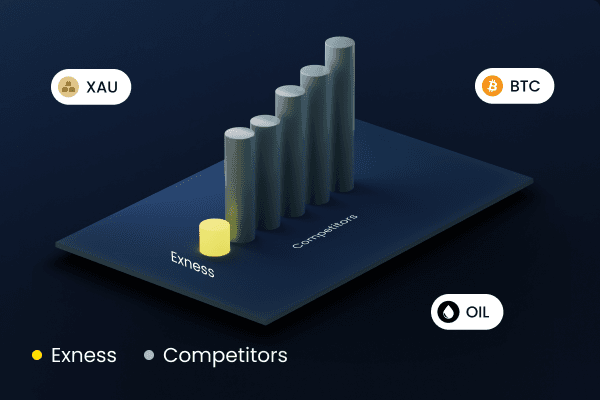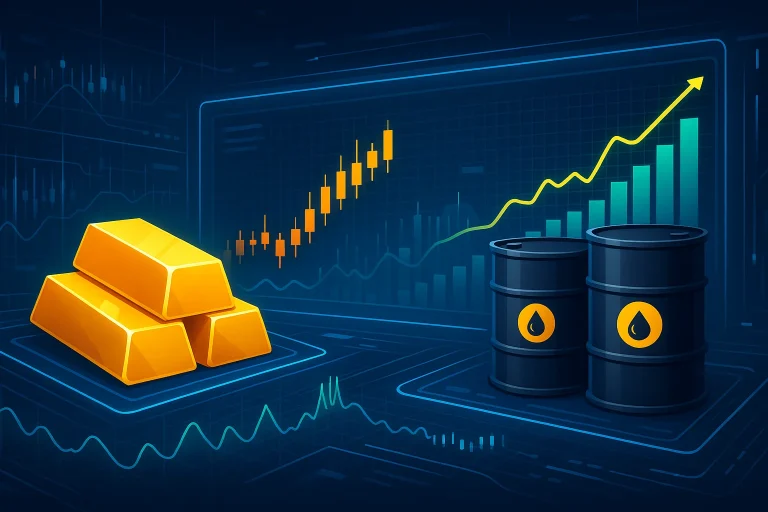Exness Commodities Trading: Metals and Energy Market Access
Home » Exness Commodities Trading
Commodities trading on Exness provides access to essential raw materials including precious metals, energy products, and agricultural goods. These instruments offer portfolio diversification opportunities and hedging capabilities against inflation and currency fluctuations. This analysis examines trading conditions, specifications, and market characteristics for commodity instruments.
Precious Metals Trading Specifications
Gold Trading Conditions
Gold (XAU/USD) represents the most actively traded precious metal on the Exness platform, offering stable trading conditions and consistent liquidity.
Gold trading specifications:
- Symbol: XAUUSD
- Contract size: 100 troy ounces
- Minimum lot size: 0.01 lots (1 troy ounce)
- Maximum lot size: 20 lots per order
- Leverage: Up to 1:unlimited (equity dependent)
- Trading hours: 24/5 except weekends
Gold spread and execution:
- Typical spread: 0.13-0.5 points
- Account type variations: Standard vs Professional
- Execution method: Market execution
- Slippage protection: Zero slippage guarantee
- Order processing: Instant execution
Account Type | Gold Spread | Commission | Total Cost | Optimal For |
Standard | 0.5 points | None | 0.5 points | Occasional trading |
Pro | 0.13 points | $1.50/lot | 0.28 points | Active trading |
Raw Spread | 0.13 points | $1.50/lot | 0.28 points | Volume trading |
Zero | 0.0 points | $1.50/lot | 0.15 points | Scalping |
Silver Trading Parameters
Silver (XAG/USD) provides additional precious metals exposure with different volatility characteristics and trading specifications.
Silver specifications:
- Symbol: XAGUSD
- Contract size: 5,000 troy ounces
- Minimum lot size: 0.01 lots (50 troy ounces)
- Maximum lot size: 8 lots per order
- Point value: $5 per point per lot
- Margin calculation: Based on current silver price
Silver market characteristics:
- Higher volatility than gold
- Industrial demand influence
- Smaller market size
- Price correlation with gold
- Economic sensitivity
Platinum and Palladium Access
Additional precious metals offer specialized trading opportunities for diversified commodity exposure.
Platinum trading details:
- Symbol: XPTUSD
- Contract size: 100 troy ounces
- Industrial applications impact
- Automotive sector correlation
- Supply concentration risks
Palladium specifications:
- Symbol: XPDUSD
- Contract size: 100 troy ounces
- Automotive industry demand
- Supply shortage scenarios
- High volatility potential
Energy Commodities Market Access
Crude Oil Trading Conditions
Crude oil represents the primary energy commodity, with multiple contract types available for different trading strategies.
WTI Crude Oil specifications:
- Symbol: USOIL
- Contract size: 1,000 barrels
- Minimum lot size: 0.01 lots (10 barrels)
- Maximum lot size: 40 lots per order
- Point value: $10 per point per lot
- Trading hours: 24/5 with brief daily maintenance
Brent Crude Oil parameters:
- Symbol: UKOIL
- Contract size: 1,000 barrels
- European benchmark reference
- North Sea oil pricing
- Global market influence
- Geopolitical sensitivity
Oil Type | Contract Size | Spread | Leverage | Market Influence |
WTI (USOIL) | 1,000 barrels | 0.03-0.08 | 1:unlimited | US markets |
Brent (UKOIL) | 1,000 barrels | 0.03-0.08 | 1:unlimited | Global markets |
Natural Gas Trading Features
Natural gas provides exposure to energy markets with seasonal patterns and weather-related volatility.
Natural gas specifications:
- Symbol: NATGAS
- Contract size: 10,000 MMBtu
- Minimum lot size: 0.01 lots
- Seasonal volatility patterns
- Weather dependency factors
- Storage capacity influences
Trading considerations:
- High volatility periods during winter
- Supply and demand imbalances
- Infrastructure constraints impact
- Economic cycle correlation
- Environmental policy influences
Agricultural Commodities Portfolio
Soft Commodities Access
Agricultural products provide exposure to food and raw material markets with unique supply and demand dynamics.
Coffee trading conditions:
- Symbol: COFFEE
- Contract size: 37,500 pounds
- Weather pattern sensitivity
- Seasonal production cycles
- Geographic concentration risks
- Currency correlation factors
Sugar market specifications:
- Symbol: SUGAR
- Contract size: 112,000 pounds
- Global consumption patterns
- Production geography impact
- Substitute product competition
- Government policy influences
Cotton trading parameters:
- Symbol: COTTON
- Contract size: 50,000 pounds
- Textile industry demand
- Weather condition dependency
- Synthetic material competition
- International trade policies

Margin Requirements and Leverage
Dynamic Margin Calculation
Commodity margin requirements adjust based on market volatility, contract specifications, and account leverage settings.
Margin calculation factors:
- Current commodity price levels
- Historical volatility measurements
- Contract size specifications
- Account leverage limitations
- Risk management parameters
Example margin calculations:
- Gold 1 lot at 1:1000 leverage: $200 margin
- Oil 1 lot at 1:500 leverage: $160 margin
- Silver 1 lot at 1:200 leverage: $125 margin
Leverage Limitations by Commodity
Different commodities have specific leverage restrictions based on volatility and market characteristics.
Commodity | Maximum Leverage | Margin Rate | Volatility Level |
Gold | 1:unlimited | 0.5% | Medium |
Silver | 1:unlimited | 1.0% | High |
Oil | 1:unlimited | 2.0% | High |
Natural Gas | 1:200 | 5.0% | Very High |
Leverage adjustment triggers:
- Market volatility increases
- Economic event proximity
- Supply/demand shocks
- Geopolitical developments
- Seasonal pattern changes
Market Hours and Trading Sessions
Commodity Trading Schedule
Commodity markets operate with specific hours that may differ from forex trading sessions, reflecting underlying physical market operations.
Standard trading hours:
- Metals: 24/5 continuous trading
- Energy: 24/5 with brief maintenance breaks
- Agricultural: Limited session availability
- Market closures: Weekends and holidays
Session-specific characteristics:
- Asian session: Limited agricultural activity
- European session: Metals and energy focus
- American session: Full market participation
- Overlap periods: Highest liquidity
Market Closure Impact
Weekend and holiday closures can create gap risks and liquidity challenges for commodity positions.
Closure considerations:
- Friday settlement prices
- Weekend news developments
- Monday opening gaps
- Holiday schedule variations
- Emergency market suspensions
Price Factors and Market Drivers
Fundamental Analysis Components
Commodity prices respond to specific fundamental factors that differ from currency and equity markets.
Supply-side factors:
- Production capacity levels
- Weather condition impacts
- Geopolitical supply disruptions
- Infrastructure constraints
- Inventory level changes
Demand-side influences:
- Economic growth patterns
- Industrial production levels
- Consumer behavior changes
- Substitute product development
- Government policy modifications
Technical Analysis Application
Technical analysis applies to commodity markets with specific considerations for contract specifications and market structure.
Technical indicators effectiveness:
- Moving averages: Trend identification
- RSI oscillator: Overbought/oversold conditions
- Support/resistance: Price level significance
- Volume analysis: Market participation
- Seasonal patterns: Historical tendencies
Analysis Type | Commodity Suitability | Time Frame | Reliability |
Trend Following | High | Medium-Long | High |
Mean Reversion | Medium | Short | Medium |
Momentum | High | Short-Medium | High |
Seasonal Patterns | Very High | Long | High |
Risk Management in Commodity Trading
Volatility Considerations
Commodities typically exhibit higher volatility than major currency pairs, requiring adjusted risk management approaches.
Volatility characteristics:
- Precious metals: Moderate volatility
- Energy products: High volatility
- Agricultural goods: Seasonal volatility
- Weather sensitivity: Extreme movements
- Supply disruptions: Sudden price spikes
Risk management adaptations:
- Reduced position sizes
- Wider stop loss levels
- Correlation monitoring
- Seasonal awareness
- News event preparation
Portfolio Diversification Benefits
Commodity trading provides diversification benefits within broader investment portfolios through different correlation patterns.
Diversification advantages:
- Inflation hedge characteristics
- Currency correlation differences
- Economic cycle variations
- Weather pattern independence
- Geopolitical risk distribution
Correlation analysis:
- Gold vs USD: Negative correlation
- Oil vs economic growth: Positive correlation
- Agricultural vs weather: Strong dependence
- Metals vs industrial demand: Moderate correlation
Frequently Asked Questions
What commodities are available for trading on Exness?
Exness offers precious metals (gold, silver, platinum, palladium), energy products (WTI and Brent crude oil, natural gas), and agricultural commodities (coffee, sugar, cotton) with varying specifications.
How do commodity spreads compare to forex spreads?
Commodity spreads are generally wider than major forex pairs due to lower liquidity, with gold spreads starting from 0.13 points and energy spreads from 0.03 points depending on account type.
What leverage is available for commodity trading?
Leverage varies by commodity, with precious metals and oil offering up to unlimited leverage (equity dependent), while natural gas is limited to 1:200 leverage due to higher volatility.
Are there specific trading hours for commodities?
Most commodities trade 24/5 like forex, but some agricultural products have limited session availability. Energy markets include brief daily maintenance breaks during low-activity periods.
How do margin requirements work for commodity positions?
Margin requirements depend on commodity price, contract size, and leverage, with dynamic adjustments based on market volatility. Gold requires approximately $200 margin per lot at 1:1000 leverage.


